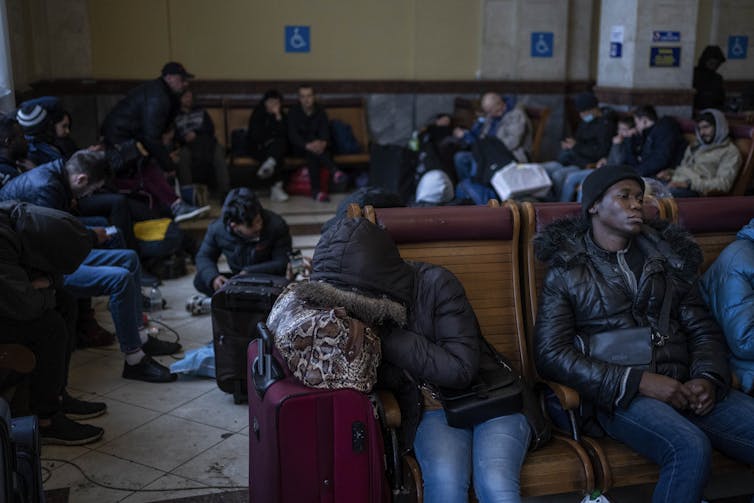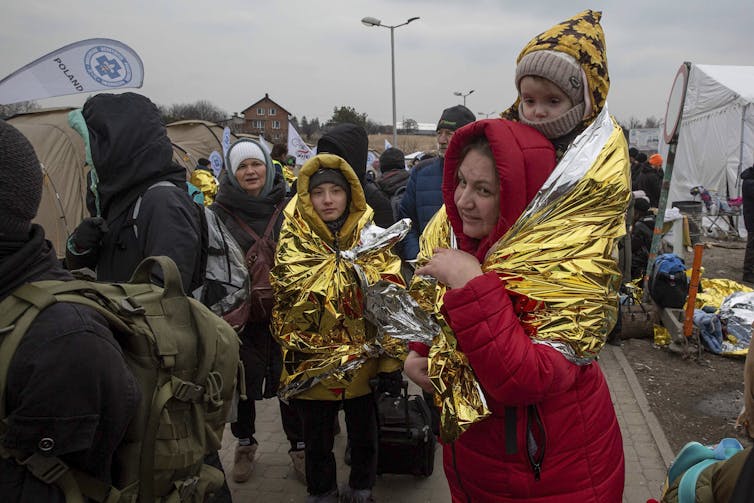
Yvonne Su, York University, Canada
Russia’s invasion of Ukraine in late February has already caused two million refugees to flee the country. The United Nations High Commissioner for Refugees predicts that another four million will be displaced if the conflict continues.
Although all neighbouring European Union countries have pledged to accept refugees from Ukraine, as people flee across borders, a complicated story emerges of who are perceived and received as good, bad and ideal refugees in modern Europe.
Take Poland — a country that is being praised globally for accepting over one million refugees from Ukraine — only months ago it was condemned for serious human rights violations after engaging in pushing back and firing tear gas at asylum seekers and migrants from the Middle East and Africa driven to the border by Belarusian forces.
How can we address these clear refugee protection gaps for Black and brown people at borders while still recognizing the tremendous efforts neighbouring countries are putting forward to those displaced?
A convention designed for war
The 1951 Refugee Convention was initially created to protect European refugees in the aftermath of the Second World War. It defines a refugee as a person who has fled their country because of a well-founded fear of persecution on one of five grounds: race, religion, nationality, membership of a particular social group or political opinion.
During war, everyone in the invaded country has a well-founded fear of persecution. Non-refoulement states that no one should be returned to a country where they would be in danger of being subjected to violations of certain fundamental rights.
Over the past 50 years, the conventions relevance has been questioned. It is hard to see it as relevant when European countries close their doors to refugees fleeing conflict from Afghanistan and Syria but open them to Ukranians.
Political theorist Steven Lukes argues that disasters, like wars, can be transformative or confirmatory as they provide an opportunity to examine the “exception” to better understand “the rule.”
What’s happening in Ukraine has unveiled the existing hierarchy of refugees that exists in modern Europe as portraits of the good, bad and ideal refugees emerge.

The good refugees
Mainstream depictions of refugees are quite generic and often comprise images of dark-skinned victimized women and children. But coverage on Ukrainian refugees has focused heavily on Ukrainian-born refugees, not all refugees from Ukraine.
Ukrainian refugees have been described as “
.”A clip from Al Jazeera described Ukrainian refugees boarding a train:
“What’s compelling is, looking at them, the way they are dressed. These are prosperous … middle-class people. These are not obviously refugees trying to get away from areas in the Middle East … North Africa.”
The bias towards Ukrainian nationals as the only worthy refugees was so strong that the E.U. had to clarify that people from third countries who lived in Ukraine and wanted to travel on to their home countries were also welcome.
The bad refugees
Comparing “intelligent,” “middle-class,” Ukrainian nationals to other refugees — like those from the Middle East and North Africa has contributed to foreign nationals being discriminated against at the borders.
Lately, many reports have surfaced of African and Indian international students being denied access to trains and border crossings. Reports have emerged of Ukrainian border officials segregating refugees by race, beating them with rods and giving preferential treatment to Ukrainian nationals. There are also accusations of preferential treatment happening in refugee programs abroad.
Black medical student Korrinne Sky, from Leicester, U.K., took to social media to share her dehumanizing journey out of Ukraine. She spoke of the clear hierarchy at the border crossings: “Ukrainians first, Indians second and Africans last.”
CTV News interviewed Black international students at the Polish border who said that they were told they had to wait aside “until [the border officials] were done with Ukrainans.” In one unverified video posted by the Guardian, a group of Black students can be heard shouting “we don’t have arms” while unidentifiable officials point guns at them.
This begs the question: Is a refugee a refugee, no matter where they come from?
Russia isn’t being selective on who they’re targeting, so everyone affected by the invasion in Ukraine should be afforded refugee protection no matter their race and nationality.
The ideal refugees
The ideal refugees are the 18- to 60-year-old men conscripted into fighting for Ukraine’s Territorial Defense Forces. They are the young men and students who have never picked up weapons before, but are now digging trenches, patrolling streets and preparing to fight to protect Ukraine.
They are the defiant women who stayed behind to make pierogies and other food, Molotov cocktails and fight.
They are the almost 80,000 Ukrainians, mostly men, who have returned from abroad.
While they are not refugees yet, if Russians continue their advances and take over Ukraine, these fighters will be displaced and there is no doubt other countries will accept them as refugees with open arms — as they should.
The problem with the ideal refugee is it exceptionalizes refugeehood. And encourages debate over which refugees deserve protection way past the definition set under the 1951 Refugee Convention.
Migration and refugee studies researcher Elena Fiddian-Qasmiyeh, in The Ideal Refugees asks readers to “reflect critically on who benefits from assertions of good, bad, and ideal refugees, and whose interests are advanced by these narratives.”
At a time when Russia’s invasion represents a threat on the world’s democracies, our global responses to refugees from Ukraine should be an opportunity for transformation not conformation. We must demand safety for all refugees, not just Ukrainian nationals.
This is a corrected version of a story originally published on March 8, 2022. The earlier story said border officials in Poland and Romania were segregating refugees by race, beating them with rods and giving preferential treatment to Ukrainian nationals but it is Ukrainian border officials at those borders.![]()
Yvonne Su, Assistant Professor in the Department of Equity Studies, York University, Canada
This article is republished from The Conversation under a Creative Commons license. Read the original article.

